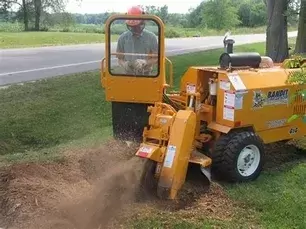 Tree stumps left behind after tree removal can be unsightly and pose obstacles in your landscape. Grinding down a tree stump is a common solution to remove it from your property entirely. However, determining how deep a tree stump should be ground down depends on various factors. In this article, we'll explore the ideal depth for stump grinding and the factors that influence it. Introduction Following the felling of a tree, the leftover stump can be unsightly and disrupt landscaping efforts. Stump grinding is an approach employed to eradicate tree stumps by grinding them down beneath the soil's surface. This technique eradicates the visible part of the stump and grinds the roots at subterranean depths, thwarting any potential regrowth. Importance of Grinding Tree Stumps Grinding tree stumps offers several benefits, including:
Factors Affecting Depth of Stump Grinding The depth to which a tree stump should be ground down depends on several factors, including: Type of Tree In Birmingham, AL, different tree species have varying root structures and growth habits, which can influence the depth of stump grinding required. Stump Size The size of the tree stump determines the extent of grinding needed to remove it completely. Larger stumps may require deeper grinding to ensure thorough removal. Root System The extent and depth of the tree's root system also affect the depth of stump grinding. Deeper roots may require more extensive grinding to prevent regrowth. Purpose of Grinding The intended use of the area where the stump is located can influence the depth of grinding. For example, if you plan to install a new landscaping feature or pave over the area, you may need to grind the stump deeper to ensure a level surface. Ideal Depth for Stump Grinding In general, tree stumps should be ground down to a depth of at least 6 to 12 inches below ground level. This depth ensures that the majority of the stump and its root system are removed, preventing regrowth and allowing for proper soil compaction and landscaping. Benefits of Grinding Stumps to the Right Depth Grinding tree stumps to the appropriate depth offers several advantages, including:
Professional vs. DIY Stump Grinding Although attempting to grind a stump yourself may appear to be a budget-friendly choice, it is important to take into account the necessary skills, tools, and potential safety hazards. Professional stump grinding companies possess the expertise and equipment needed to efficiently and safely grind stumps to the correct depth. Considerations for Hiring a Stump Grinding Service When hiring a stump grinding service, consider the following factors:
Cost of Stump Grinding The cost of stump grinding varies depending on factors such as stump size, accessibility, and location. On average, stump grinding can range from $75 to $300 per stump, with larger or more challenging stumps costing more to remove. Safety Precautions Stump grinding can be hazardous, so it's essential to take proper safety precautions, including wearing protective gear such as gloves, safety glasses, and ear protection. Keep pets and children away from the work area, and follow the manufacturer's instructions for operating stump grinding equipment safely. Environmental Impact While stump grinding is generally considered an environmentally friendly method of stump removal, it's essential to consider potential impacts such as soil compaction and disruption to nearby vegetation. Minimize environmental harm by selecting experienced professionals who prioritize sustainable practices and proper waste disposal. Conclusion Determining the ideal depth for stump grinding depends on various factors, including tree species, stump size, root system, and intended use of the area. Grinding stumps to the appropriate depth ensures thorough removal, prevents regrowth, and enhances the aesthetics and safety of your landscape. In Birmingham, AL, whether you choose to hire a professional stump grinding service or tackle the job yourself, prioritize safety, quality, and environmental responsibility for optimal results. Comments are closed.
|
AuthorOwner of Birmingham Tree Service - Charles W Young Archives
April 2024
Categories
All
|

 RSS Feed
RSS Feed